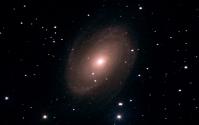Strongly Celestial Looking outward; looking backward in time... |
|||
 |
|||
Deep Space Gallery These are my pictures of the deep space objects. As with all of my galleries, click on the picture itself to bring up a larger, scaleable copy of the picture in a separate window; be sure to expand that window to see the full size of the image! |
||
Subject: Andromeda Galaxy (M31) Equipment: Comments |
||||
Subject: Andromeda Galaxy (M31) plus M32 and M110 Equipment Comments |
||||
Subject: Orion Nebula (M42) Equipment Comments |
||||